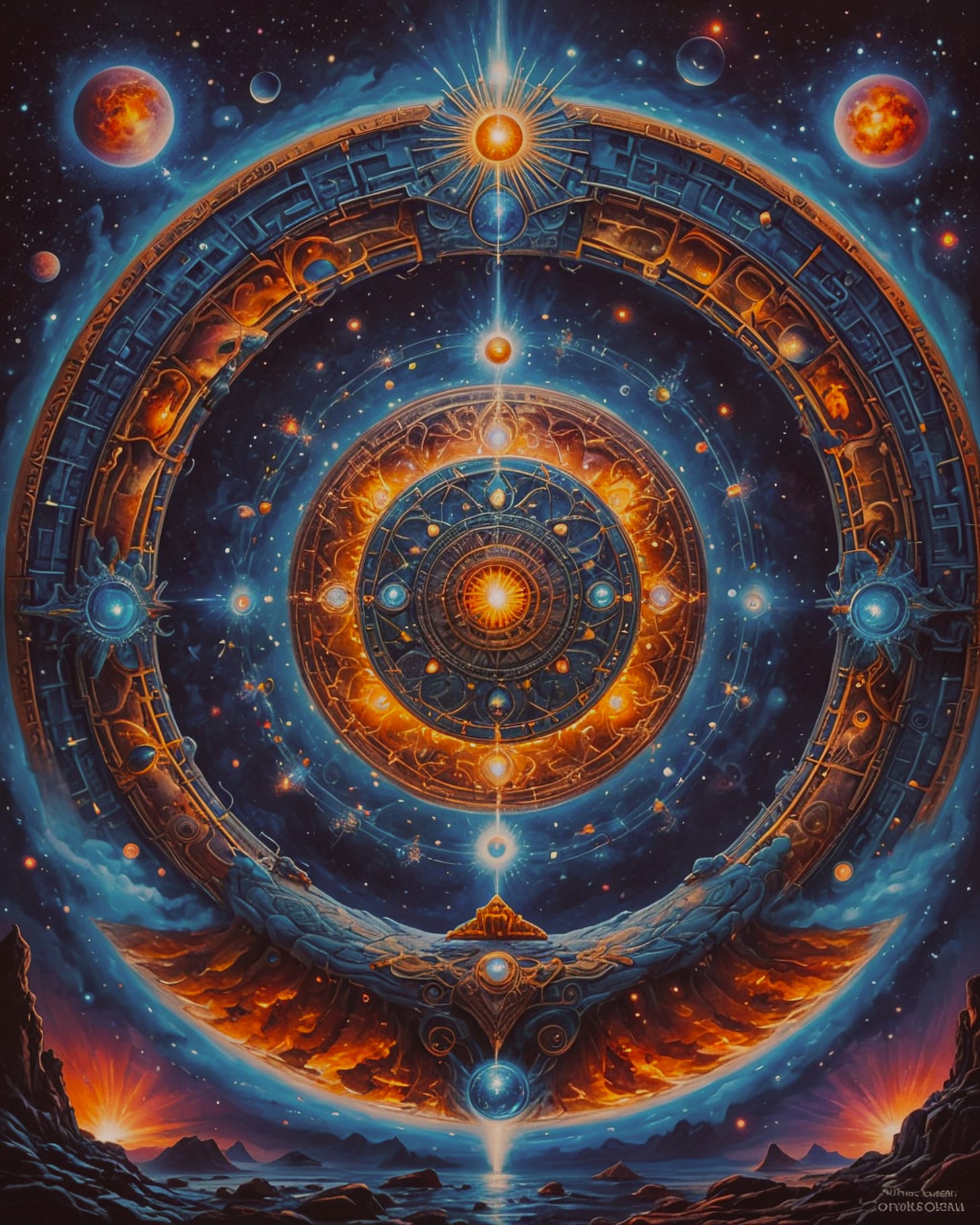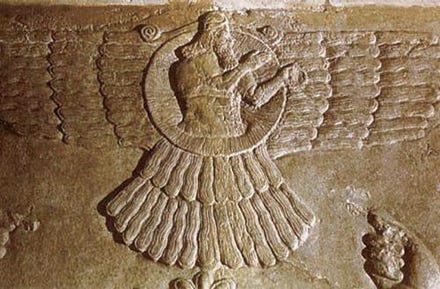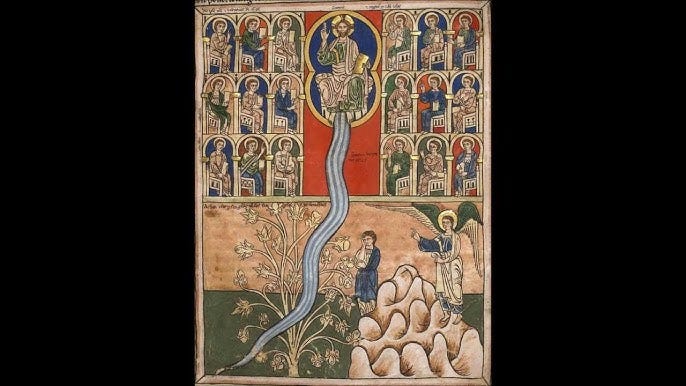Chapter 6: Through the Spheres of the Midst
And the tree of eternal life is as it appeared by God’s will, to the north of Paradise, so that it might make eternal the souls of the pure, who shall come forth from the modelled forms of poverty at the consummation of the age. Now the color of the tree of life is like the sun. And its branches are beautiful. Its leaves are like those of the cypress. Its fruit is like a bunch of grapes when it is white. Its height goes as far as heaven. And next to it (is) the tree of knowledge (gnosis), having the strength of God. (On the Origin of the World).
The “Tree of Life” motif is a universal one. It represents the entire Multiverse as it does denote the human anatomy and soul-spirit complex. As many scholars have pointed out, the tree of life can be traced back to Assyrian mythology. One stele, displayed at the British Museum, it depicts the Assyrian Tree of Life. These immortal trees are typically flanked by a pair “winged genii,” often with animal heads and four wings, as in the vision of Ezekiel. The cherubim may also be equated with the protective Babylonian and Assyrian “lamassu” and the Greek and Egyptian Sphinxes.
Comparative religious scholars generally interpret the Tree of Life as a version of the Axis Mundi, a symbol that depicts the center of the cosmos and even the pillars that hold heaven and earth apart. (More on this later.) The Tree of Life also functions as a gateway or a portal to another reality. Genesis 3:22 (NRSV) states, it is also a touchpoint for immortality when the “Lord God” warns the other Elohim in the Divine Council: “Behold, the man has become like one of us, knowing good and evil; and now, lest he put forth his hand and also take of the tree of life, and eat, and live forever.”
Our first stele comes from the palace of Nimrud (Nimrod?), an early capital of the Neo-Assyrian empire of the first millennium BCE. Located in present-day Iraq, the Assyrians ruled the epicenter of their kingdom where Sumer and the Babylonian empire had stood long before. The stele depicts twin images of King Ashurnasirpal II (ca. 883 B.C.–859 B.C.), the first great king of the Neo-Assyrians, on either side of the Tree, wearing ritual robes. Surrounding the king, acting as guardians, are two winged genii. Above the Tree hovers a winged sun disk representing the royal god Ashur, the Assyrian equivalent of the Babylonian god Marduk, hero of the creation saga Enuma Elish. As we saw earlier, this great epic chronicles the creation of the world and the establishment of the order of heaven and earth. After slaying the monstrous Tiamat, the god-hero Marduk is rewarded with kingship of the gods. From the bones of his defeated foe, Marduk creates the world and establishes the forever-repeating cycles of the heavens:
[Marduk/Ashur] fashioned heavenly stations for the great gods, and set up constellations, the patterns of the stars.
He appointed the year, marked off divisions, and set up three stars each for the twelve months.
After he had organized the year, He established the heavenly station of Ne-beru to fix the stars’ intervals. (3)
Both Ashur and Marduk are associated with the celestial order, marked by the astrological circuits of the heavenly bodies, and likewise associated with the divine mandate to rule. This stele proclaims the divine legitimacy of Ashurnasirpal II, who acts as custodian to the Tree of Life itself.
Christ Enthroned Over the River of Life by Beatus of Liébana.
The deified Assyrian and Babylonian sacral kings often resembled God in Revelation and Ezekiel. God was often pictured as a crowned and enthroned humanoid with streams of living waters flowing from his divine chariot to water the tree of life. Manly P. Hall thinks that the lamb symbolizing Christ is evidence of Persian influence on Revelation, as stated in The Secret Teachings of All Ages (p. 186):
In the fourth and fifth chapters St. John describes the throne of God upon which sat the Holy One “which was and is, and is to come.” About the throne were twenty-four lesser seats upon which sat twenty-four elders arrayed in white garments and wearing crowns of gold. “And out of the throne proceeded lightnings and thunderings and voices: and there were seven lamps of fire burning before the throne, which are the seven Spirits of God.” He who sat upon the throne held in His right hand a book sealed with seven seals which no man in heaven or earth had been found worthy to open. Then appeared a Lamb (Aries, the first and chief of the zodiacal signs) which had been slain, having seven horns (rays) and seven eyes (lights). The Lamb took the book from the right hand of Him that sat upon the throne and the four beasts and all the elders fell down and worshiped God and the Lamb. During the early centuries of the Christian Church the lamb was universally recognized as the symbol of Christ, and not until after the fifth synod of Constantinople (the “Quinisext Synod,” A.D. 692) was the figure of the crucified man substituted for that of Agnus Dei. As shrewdly noted by one writer on the subject, the use of a lamb is indicative of the Persian origin of Christianity, for the Persians were the only people to symbolize the first sign of the zodiac by a lamb.
Because a lamb was the sin offering of the ancient pagans, the early mystic Christians considered this animal as an appropriate emblem of Christ, whom they regarded as the sin offering of the world. The Greeks and the Egyptians highly venerated the lamb or ram, often placing its horns upon the foreheads of their gods. The Scandinavian god Thor carried a hammer made from a pair of ram’s horns. The lamb is used in preference to the ram apparently because of its purity and gentleness; also, since the Creator Himself was symbolized by Aries, His Son would consequently be the little Ram or Lamb. The lambskin apron worn by the Freemasons over that part of the body symbolized by Typhon or Judas represents that purification...
Many throughout history have interpreted the central theme of the Gospel of Jesus, “The Kingdom of God”, as a future earthly kingdom. This is to my mind a much too narrow understanding ignoring that the kingdom of God is also a central theme in Gnostic religion. The Garden of Eden portrayed in Genesis can be thought of a timeless realm where the Divine and Humanity shared a united existence. This is the same as the Saturnian Golden Age myths of the Greeks, Romans, and the Hindu’s in the Vedas. Hesiod in Works and Days (110), even tells us that under the age of Chronos, men were golden!
A golden race of mortal men who lived in the time of Chronos when he was reigning in heaven. And they lived like gods without sorrow of heart, remote and free from toil: miserable age rested not on them . . . The fruitful earth unforced bare them fruit abundantly and without stint. They dwelt in ease and peace upon their lands with many good things. . . .[1]
In the center of the Garden, there was a tree of life. Only the Hebrew and the Assyrian/Babylonian literature share the legend of the tree of life.
And the LORD God planted a garden in Eden, in the east; and there he put the man whom he had formed. Out of the ground the LORD God made to grow every tree that is pleasant to the sight and good for food, the tree of life also in the midst of the garden, and the tree of the knowledge of good and evil. (Genesis 2:8)
There are some references to the tree of life outside the Old Testament. For example, the Ethiopic Book of Enoch (xxiv. 4) states that the tree of life “excelled” other trees in height—all of which were surrounding a gigantic “seventh” mountain. The Tree of Life apparently had a fragrance “beyond all fragrance,” while its wood and leaves “wither not forever” and its fruit resembles the palm dates. In the same book, it is revealed that the Tree of Life is off-limits to mere mortals, like in Genesis.
And as for this fragrant tree no mortal is permitted to touch it till the great judgement, when He shall take vengeance on all and bring (everything) to its consummation for ever. It shall then be given to the righteous and holy. Its fruit shall be for food to the elect: it shall be transplanted to the holy place, to the temple of the Lord, the Eternal King.
Then shall they rejoice with joy and be glad,
And into the holy place shall they enter;
And its fragrance shall be in their bones,
And they shall live a long life on earth,
Such as thy fathers lived:
And in their days shall no sorrow or plague
Or torment or calamity touch them.’
However, Assyrians and Babylonians share the common legend of the tree of life and a Utopian land called the island of dilmun, which is now located in Bahrain. Why? Assyrians used to live in the north and the Babylonians in the south of the region trapped between Euphrates and Tigris. It is most likely that the Jews incorporated the legend of the tree of life, creation, and deluge during their Babylonian captivity and into the Torah.
In The Tree of Knowledge as the Veil of the Sanctuary by Jeffrey M. Bradshaw, he tells us that the Garden of Eden is essentially the “axis mundi” or “the navel” center of the world that covers the “Foundation Stone”. The World Tree or Eden (sprouting over the Foundation Stone perhaps), like God’s Throne, also acts like a center-point for all of existence and are intimately connected as seen earlier.
Michael A. Fishbane describes the Garden of Eden as “an axis mundi. From it radiate primal streams to the four quarters. . . . It is the navel oromphalos,” and the tree of life stands at “the center of this center.” Explaining the choice of a tree to represent the concepts of life, earth, and heaven in ancient cultures, Terje Stordalen writes, “Every green tree would symbolize life, and a large tree—rooted in deep soil and stretching towards the sky—potentially makes a cosmic symbol. In both cases it becomes a ‘symbol of the centre.’”
Ezekiel 28:13 places Eden on the mountain of God. “Eden, as a luxuriant cosmic mountain becomes an archetype or symbol for the earthly temple.” Described by Isaiah as “the mountain of the Lord’s house” (Isaiah 2:2), the Jerusalem temple can be identified—like Eden—as a symbol of the center. Israelite traditions asserted that the foundation stone in front of the ark within the Holy of Holies of the temple at Jerusalem “was the first solid material to emerge from the waters of creation [see Psalm 104:7–9], and it was upon this stone that the Deity effected creation.”
In the same article, Bradshaw tells us that the Tree of Knowledge itself acted as a veil to the Holy of Holies in Eden, where God dwelled. It was Satan, who deceived both Adam and Eve, who not only presented himself as the seraphim serpent Jesus but also made the tree of knowledge to look like the tree of life!
Keep reading with a 7-day free trial
Subscribe to The Megas Aeon to keep reading this post and get 7 days of free access to the full post archives.









